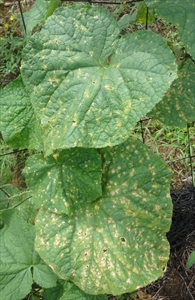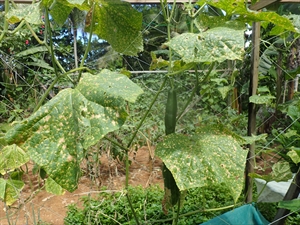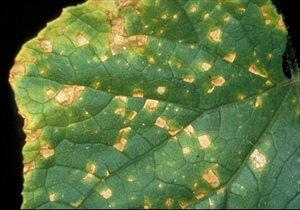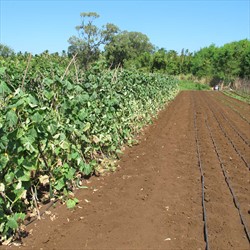Cucumber target spot, cucumber leaf spot, Corynespora blight
Pacific Pests, Pathogens, Weeds & Pesticides - Online edition
Pacific Pests, Pathogens, Weeds & Pesticides
Cucumber target spot (189)
Corynespora cassiicola
Asia, Africa, North, South and Central America, the Caribbean, Europe, Oceania. It is recorded on cucurbits from the Cook Islands, Federated States of Micronesia, Fiji, and Vanuatu.
Common on a wide range of crops, including, beans and other legumes, capsicum, cucumber (see Fact Sheet no. 189) and other cucurbits, lettuce, papaya, tomato. Ornamentals and weeds are also hosts. The fungus causes an important disease of tomato in Pacific islands (see Fact Sheet no. 163). It is also reported to be a disease of rubber in Asia and Africa.
Numerous cream-coloured round spots, up to 4 mm diameter; often, irregular shaped or angular, bordered by veins (Photos 1-5). The leaves dry out and fall prematurely (Photo 6). Fruits of cucumber are not affected. The fungus is a secondary invader of rotting fruits of papaya and tomato.
The spores are spread by wind-blown rain, and if windy wet weather continues for a few days, spread is fast and plants lose their leaves quickly.
The source of the fungus is from other infected crops, the remains of the previous crop and, perhaps, other host species. The fungus is very common on papaya leaves causing angular, light brown or grey spots, 2 mm diameter, sometimes surrounded by a yellow margin; the centres of the spots often fall out producing a 'shot-hole' effect.
A fungus causes this disease. Where rainfall is high and large numbers of small spots occur on the leaves, they dry out, fall down, the plants die prematurely, and yields are seriously affected (Photo 2). The fungus also causes a leaf spot on papaya, and a common and serious disease on tomato, also called target spot (see Fact sheet no. 163).
Look for round, but often angular, cream spots on the leaves, bounded by the veins.
CULTURAL CONTROL
Cultural control is important. The following should be done:
Before planting:
- Do not plant new crops next to older ones that have the disease.
- Plant as far as possible from papaya, especially if leaves have small angular spots, with 'shot-hole' symptoms.
- Check all seedlings in the nursery, and throw away any with leaf spots.
During growth:
- Keep plots free from weeds, as some may be hosts of the fungus.
- Grow cucumbers on a trellis or vertical wires to increase air circulation around them. If the leaves dry quickly, there is less time for the spores to germinate and infect.
- Do not work in the cucumbers plots when leaves are wet, especially if some plants have signs of leaf spot. Touching the plants can help to spread the disease in water droplets.
After harvest:
- Collect and burn as much of the crop as possible when harvest is complete.
- Practice crop rotation, leaving 3 years before replanting cucumber on the same land.
RESISTANT VARIETIES
There are reports of varieties with resistance to leaf spot. Check with retailers (or seed catalogues) if any are available in your country.
CHEMICAL CONTROL
Warm wet conditions favour the disease such that fungicides are needed to give adequate control. The products to use are chlorothalonil, copper oxychloride or mancozeb. Treatment should start when the first spots are seen and continue at 10-14-day intervals until 3-4 weeks before last harvest. It is important to spray both sides of the leaves.
____________________
When using a pesticide, always wear protective clothing and follow the instructions on the product label, such as dosage, timing of application, and pre-harvest interval. Recommendations will vary with the crop and system of cultivation. Expert advice on the most appropriate pesticides to use should always be sought from local agricultural authorities.
AUTHOR Grahame Jackson
Information from Corynespora blight (Corynespora cassiicola) in Southern Plant Diagnostic Network (undated) Invasive.org. (https://www.invasive.org/collections/viewcollection.cfm?id=3566). Photos 2&3 Konrad Englberger, Pohnpei, Federated States of Micronesia. Photo 5 Kohler F, et al. (1997) Diseases of cultivated crops in Pacific Island countries. South Pacific Commission. Pirie Printers Pty Limited, Canberra, Australia.
Produced with support from the Australian Centre for International Agricultural Research under project PC/2010/090: Strengthening integrated crop management research in the Pacific Islands in support of sustainable intensification of high-value crop production, implemented by the University of Queensland and the Secretariat of the Pacific Community.









